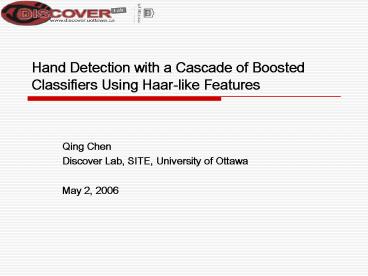Hand Detection with a Cascade of Boosted Classifiers Using Haarlike Features - PowerPoint PPT Presentation
1 / 15
Title:
Hand Detection with a Cascade of Boosted Classifiers Using Haarlike Features
Description:
Hand Detection with a Cascade of Boosted Classifiers Using Haar-like Features. Qing Chen ... AdaBoost (Adaptive Boost) is an iterative learning algorithm to ... – PowerPoint PPT presentation
Number of Views:652
Avg rating:3.0/5.0
Title: Hand Detection with a Cascade of Boosted Classifiers Using Haarlike Features
1
Hand Detection with a Cascade of Boosted
Classifiers Using Haar-like Features
- Qing Chen
- Discover Lab, SITE, University of Ottawa
- May 2, 2006
2
Outline
- 1. Introduction
- 2. Haar-like features
- 3. Adaboost
- 4. The Cascade of Classifiers
- 5. Preliminary Results
- 6. Future Work
3
1. Introduction
- Hand-based Human Computer Interface (HCI) should
meet the requirements of real-time, accuracy and
robustness. - The purpose of Haar-like features is to meet the
real-time requirement. - The purpose of the cascade of Adaboosted
(Adaptive boost) classifiers is to achieve both
accuracy and speed. - The algorithm has been used for face detection
which achieved high detection accuracy and
approximately 15 times faster than any previous
approaches. - The algorithm is a generic objects
detection/recognition method.
4
2. Haar-Like Features
- Each Haar-like feature consists of two or three
jointed black and white rectangles - The value of a Haar-like feature is the
difference between the sum of the pixel gray
level values within the black and white
rectangular regions - f(x)Sumblack rectangle (pixel gray level)
Sumwhite rectangle (pixel gray level) - Compared with raw pixel values, Haar-like
features can reduce/increase the
in-class/out-of-class variability, and thus
making classification easier.
Figure 1 A set of basic Haar-like features.
Figure 2 A set of extended Haar-like features.
5
2. Haar-Like Features (contd)
- The rectangle Haar-like features can be computed
rapidly using integral image. - Integral image at location of x, y contains the
sum of the pixel values above and left of x, y,
inclusive - The sum of pixel values within D
6
2. Haar-Like Features (contd)
- To detect the hand, the image is scanned by a
sub-window containing a Haar-like feature. - Based on each Haar-like feature fj , a weak
classifier hj(x) is defined as where x is a
sub-window, and ? is a threshold. pj indicating
the direction of the inequality sign.
7
3. Adaboost
- The computation cost using Haar-like
featuresExample original image size 320X240,
sub-window size 24X24,
frame rate 15 frame/second,The total number
of sub-windows with one Haar-like feature per
second
(320-241)X(240-241)X15966,735
Considering the scaling factor and the total
number of Haar-like features, the computation
cost is huge. - AdaBoost (Adaptive Boost) is an iterative
learning algorithm to construct a strong
classifier using only a training set and a weak
learning algorithm. A weak classifier with the
minimum classification error is selected by the
learning algorithm at each iteration. - AdaBoost is adaptive in the sense that later
classifiers are tuned up in favor of those
sub-windows misclassified by previous
classifiers.
8
3. Adaboost (contd)
- The algorithm
9
3. Adaboost (contd)
- Adaboost starts with a uniform distribution of
weights over training examples. The weights
tell the learning algorithm the importance of the
example. - Obtain a weak classifier from the weak learning
algorithm, hj(x). - Increase the weights on the training examples
that were misclassified. - (Repeat)
- At the end, carefully make a linear combination
of the weak classifiers obtained at all
iterations.
10
4. The Cascade of Classifiers
- A series of classifiers are applied to every
sub-window. - The first classifier eliminates a large number of
negative sub-windows and pass almost all positive
sub-windows (high false positive rate) with very
little processing. - Subsequent layers eliminate additional negatives
sub-windows (passed by the first classifier) but
require more computation. - After several stages of processing the number of
negative sub-windows have been reduced radically.
11
4. The Cascade of Classifiers (contd)
- Negative samples non-object images. Negative
samples are taken from arbitrary images. These
images must not contain object representations. - Positive samples images contain object (hand in
our case). The hand in the positive samples must
be marked out for classifier training.
12
5. Preliminary Results
- Number of pos. samples 144
- Number of neg. samples 3142
- Sample Resolution 640X480
- Initial sub-window size 15X30
- Scale factor 1.3
- Cascade obtained 12 grades
13
6. Future Work
- Extended Haar-like features? Will extended
Haar-like features improve the detection
accuracy? (Still an Open Problem) The performance
tradeoff? - Parallel cascades for multiple hand gestures. How
to select the hand gesture configurations which
can be detected more effectively with the
employed Haar-like feature set? - Improve the robustness against hand rotation.
- How much improvement can be achieved with more
training samples? Intel face detection
classifier 5000 Pos. 10000 Neg. Accuracy 98
14
References
- Wu Bo, et al., A Multi-View Face Detection Based
on Real Adaboost Algorithm, Computer Research
and Development, 42 (9)pp.1612-1621,2005. - Paul Viola and Michael J. Jones, Robust
Real-time Object Detection, Technical Report,
Cambridge Research Lab, Compaq. 2001. - Cynthia Rudin, Robert E. Schapire, Ingrid
Daubechies, Analysis of Boosting Algorithms
using the Smooth Margin Function A Study of
Three Algorithms, 2004. - Rainer Lienhart, Alexander Kuranov, Vadim
Pisarevsky, Empirical Analysis of Detection
Cascades of Boosted Classifiers for Rapid Object
Detection, MRL Technical Report, May 2002. - Andre L. C. Barczak, Farhad Dadgostar, Real-time
Hand Tracking Using a Set of Cooperative
Classifiers and Haar-Like Features, Research
Letters in the Information and Mathematical
Sciences, ISSN 1175-2777, Vol. 7, pp 29-42, 2005. - Mathias Kölsch and Matthew Turk, Robust Hand
Detection, Proc. IEEE Intl. Conference on
Automatic Face and Gesture Recognition, May 2004.
- Intel OpenCV Documents.
- Acknowledgement goes to Urthos training data for
eye detection and F. Dadgostars hand palm
database.
15
Thank you and Any Questions?































